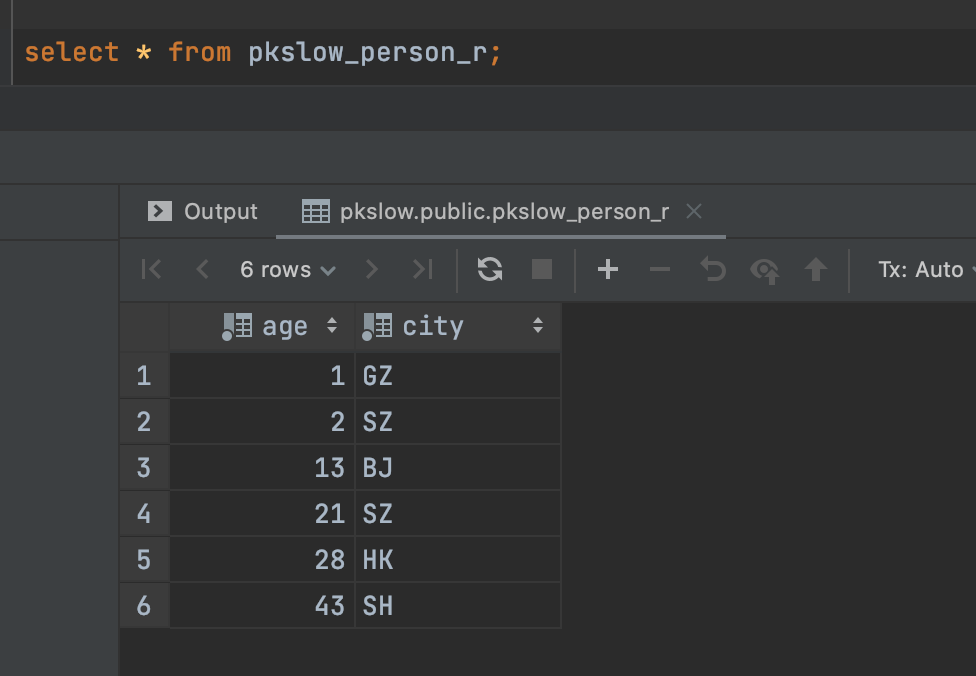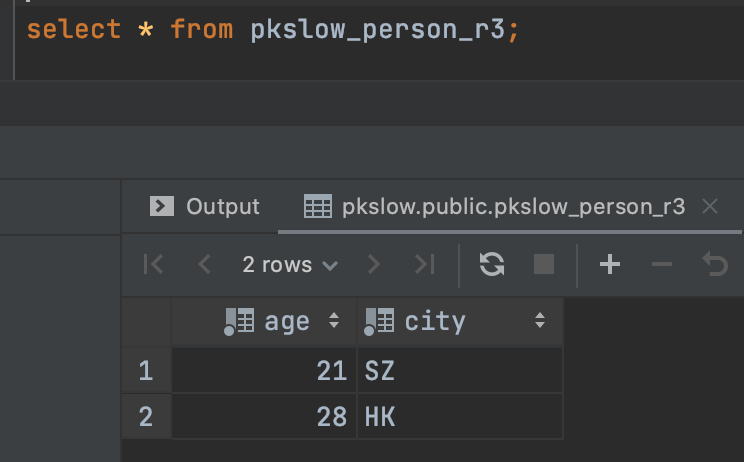您现在的位置是:网站首页> 编程资料编程资料
浅谈PostgreSQL表分区的三种方式_PostgreSQL_
![]() 2023-05-27
463人已围观
2023-05-27
463人已围观
简介 浅谈PostgreSQL表分区的三种方式_PostgreSQL_
一、简介
表分区是解决一些因单表过大引用的性能问题的方式,比如某张表过大就会造成查询变慢,可能分区是一种解决方案。一般建议当单表大小超过内存就可以考虑表分区了。PostgreSQL的表分区有三种方式:
- Range:范围分区;
- List:列表分区;
- Hash:哈希分区。
本文通过示例讲解如何进行这三种方式的分区。
二、三种方式
为方便,我们通过Docker的方式启动一个PostgreSQL。我们要选择较高的版本,否则不支持Hash分区,命令如下:
docker run -itd \
--name pkslow-postgres \
-e POSTGRES_DB=pkslow \
-e POSTGRES_USER=pkslow \
-e POSTGRES_PASSWORD=pkslow \
-p 5432:5432 \
postgres:13
2.1、Range范围分区
先创建一张表带有年龄,然后我们根据年龄分段来进行分区,创建表语句如下:
CREATE TABLE pkslow_person_r ( age int not null, city varchar not null ) PARTITION BY RANGE (age);
这个语句已经指定了按age字段来分区了,接着创建分区表:
create table pkslow_person_r1 partition of pkslow_person_r for values from (MINVALUE) to (10); create table pkslow_person_r2 partition of pkslow_person_r for values from (11) to (20); create table pkslow_person_r3 partition of pkslow_person_r for values from (21) to (30); create table pkslow_person_r4 partition of pkslow_person_r for values from (31) to (MAXVALUE);
这里创建了四张分区表,分别对应年龄是0到10岁、11到20岁、21到30岁、30岁以上。
接着我们插入一些数据:
insert into pkslow_person_r(age, city) VALUES (1, 'GZ'); insert into pkslow_person_r(age, city) VALUES (2, 'SZ'); insert into pkslow_person_r(age, city) VALUES (21, 'SZ'); insert into pkslow_person_r(age, city) VALUES (13, 'BJ'); insert into pkslow_person_r(age, city) VALUES (43, 'SH'); insert into pkslow_person_r(age, city) VALUES (28, 'HK');
可以看到这里的表名还是pkslow_person_r,而不是具体的分区表,说明对于客户端是无感知的。
我们查询也一样的:

但实际上是有分区表存在的:

而且分区表与主表的字段是一致的。
查询分区表,就只能查到那个特定分区的数据了:

2.2、List列表分区
类似的,列表分区是按特定的值来分区,比较某个城市的数据放在一个分区里。这里不再给出每一步的讲解,代码如下:
-- 创建主表 create table pkslow_person_l ( age int not null, city varchar not null ) partition by list (city); -- 创建分区表 CREATE TABLE pkslow_person_l1 PARTITION OF pkslow_person_l FOR VALUES IN ('GZ'); CREATE TABLE pkslow_person_l2 PARTITION OF pkslow_person_l FOR VALUES IN ('BJ'); CREATE TABLE pkslow_person_l3 PARTITION OF pkslow_person_l DEFAULT; -- 插入测试数据 insert into pkslow_person_l(age, city) VALUES (1, 'GZ'); insert into pkslow_person_l(age, city) VALUES (2, 'SZ'); insert into pkslow_person_l(age, city) VALUES (21, 'SZ'); insert into pkslow_person_l(age, city) VALUES (13, 'BJ'); insert into pkslow_person_l(age, city) VALUES (43, 'SH'); insert into pkslow_person_l(age, city) VALUES (28, 'HK'); insert into pkslow_person_l(age, city) VALUES (28, 'GZ');当我们查询第一个分区的时候,只有广州的数据:

2.3、Hash哈希分区
哈希分区是指按字段取哈希值后再分区。具体的语句如下:
-- 创建主表 create table pkslow_person_h ( age int not null, city varchar not null ) partition by hash (city); -- 创建分区表 create table pkslow_person_h1 partition of pkslow_person_h for values with (modulus 4, remainder 0); create table pkslow_person_h2 partition of pkslow_person_h for values with (modulus 4, remainder 1); create table pkslow_person_h3 partition of pkslow_person_h for values with (modulus 4, remainder 2); create table pkslow_person_h4 partition of pkslow_person_h for values with (modulus 4, remainder 3); -- 插入测试数据 insert into pkslow_person_h(age, city) VALUES (1, 'GZ'); insert into pkslow_person_h(age, city) VALUES (2, 'SZ'); insert into pkslow_person_h(age, city) VALUES (21, 'SZ'); insert into pkslow_person_h(age, city) VALUES (13, 'BJ'); insert into pkslow_person_h(age, city) VALUES (43, 'SH'); insert into pkslow_person_h(age, city) VALUES (28, 'HK');
可以看到创建分区表的时候,我们用了取模的方式,所以如果要创建N个分区表,就要取N取模。
随便查询一张分区表如下:

可以看到同是SZ的哈希值是一样的,肯定会分在同一个分区,而BJ的哈希值取模后也属于同一个分区。
三、总结
本文讲解了PostgreSQL分区的三种方式。
代码请查看:https://github.com/LarryDpk/pkslow-samples
以上就是浅谈PostgreSQL表分区的三种方式的详细内容,更多关于PostgreSQL表分区的资料请关注其它相关文章!
相关内容
- postgres之jsonb属性的使用操作_PostgreSQL_
- postgresql无序uuid性能测试及对数据库的影响_PostgreSQL_
- 如何使用PostgreSQL进行中文全文检索_PostgreSQL_
- PostgreSQL通过oracle_fdw访问Oracle数据的实现步骤_PostgreSQL_
- Centos环境下Postgresql 安装配置及环境变量配置技巧_PostgreSQL_
- 自定义函数实现单词排序并运用于PostgreSQL(实现代码)_PostgreSQL_
- PostgreSQL将数据加载到buffer cache中操作方法_PostgreSQL_
- 在PostgreSQL中使用ltree处理层次结构数据的方法_PostgreSQL_
- postgresql 中的时间处理小技巧(推荐)_PostgreSQL_
- Postgresql限制用户登录错误次数的实例代码_PostgreSQL_





